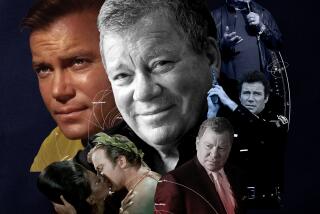‘Beltway’ Takes Buddy Approach to Punditry
- Share via
WASHINGTON — Fred Barnes and Morton Kondracke used to be John McLaughlin’s boys.
That meant making a deal with the Jesuit-priest-turned-devilish-despot who started “The McLaughlin Group” and kicked off the era of political punditry as contact sport on cable. The advantages were irresistible to two lifelong newspaper guys: more money, improved access to newsmakers, status at Georgetown cocktail parties, the occasional autograph request.
Only as the show became more successful, McLaughlin conferred more headaches than social standing. The host turned imperious and domineering. His on-air nicknames for them became more condescending. No longer could Barnes and Kondracke count on being panelists each week. A young assistant would call each week and notify them whether “Dr. McLaughlin” required their services. Friday afternoon tapings became nightmares, stretching on for hours. They’d stretch on into the evening if one panelist made the mistake of mentioning flight plans out of town that afternoon.
So Barnes and Kondracke said “bye-bye,” to borrow McLaughlin’s sign-off, and left his show for their own on Fox News Channel after 10 and 16 years, respectively. Since the summer of 1998, they’ve been their own boys--the Beltway Boys--and seem to truly enjoy practicing punditry for the first time. “The Beltway Boys” is broadcast Saturdays at 6 p.m. on Fox, then again Sunday at 8 a.m. and 4 p.m.
“I can’t tell you how ruinous to the digestive system McLaughlin was. You’d leave the show thinking, ‘I must have looked like a jerk today,’ ” Kondracke said over a steak lunch with his partner.
“Sometimes it was true,” Barnes added.
Barnes and Kondracke were often pitted against each other on “McLaughlin,” where Kondracke played the slightly left-leaning centrist and Barnes sat in the conservative pit-bull chair once occupied by Robert Novak and Pat Buchanan. When the longtime friends designed their own show, they wanted to prove that pundits could be pals. Think “Siskel and Ebert on Capitol Hill” instead of “McLaughlin.”
“ ‘Siskel and Ebert’s’ close, except that I don’t think they really liked each other. We like each other,” said Barnes, whose day job is executive editor of the conservative Weekly Standard magazine. “I refer to ‘The Beltway Boys’ not as an adversarial show like ‘McLaughlin’ but a buddy show, a buddy show where friends disagree. I’m obviously a lot more conservative than Mort, but we’re not yelling. We respect each other’s opinions.”
“Well, most of the time,” added Kondracke, by day a columnist and executive editor of the D.C. semi-weekly Roll Call.
What “Beltway Boys” borrows from “McLaughlin” is an emphasis on speed, quick-but-informed insights behind the headlines, and fun gimmicks, like the weekly buzz in place of McLaughlin’s show-ending predictions. The gimmicks have turned them into favorite targets in Brill’s Content, a monthly journalism magazine, in which the accuracy of the Beltway Boys’ buzz has recently ranked below predictions made by the magazine’s pet chimp (“Hey, smart chimp,” Barnes quips).
“My biggest goal is that the show be fun to watch while still being a serious show about news and politics,” Barnes said. “ ‘McLaughlin’ for years was fun to watch--until we left. Chris Matthews’ show is fun to watch. It’s lively. It’s fun. That’s why I always object to ‘Washington Week in Review.’ It ain’t fun. It’s deadly. A show like ours has to be fun. We’re not seeking a Nobel Peace Prize here. Ultimately, this is television.”
Indeed, television was the last place that either Barnes, 56, or Kondracke, 60, expected to make his name. Barnes started as an $85-a-week local reporter. Kondracke covered cops outside Chicago for $106. Each thought he had hit his career pinnacle covering the White House--Barnes for the Baltimore Sun, Kondracke for New Republic--or when each was asked to pose questions to then-President Ronald Reagan and Democratic challenger Walter Mondale during 1984 presidential debates.
Then McLaughlin’s pundit show and the rise of 24-hour cable news changed the very nature of Washington reporting.
“The profession is just totally different,” Barnes said. “I always thought if I was a total success, I would rise to the level of covering the House of Representatives for the New York Times or the Senate for the Washington Post. Now there’s television.”
More to Read
The complete guide to home viewing
Get Screen Gab for everything about the TV shows and streaming movies everyone’s talking about.
You may occasionally receive promotional content from the Los Angeles Times.






